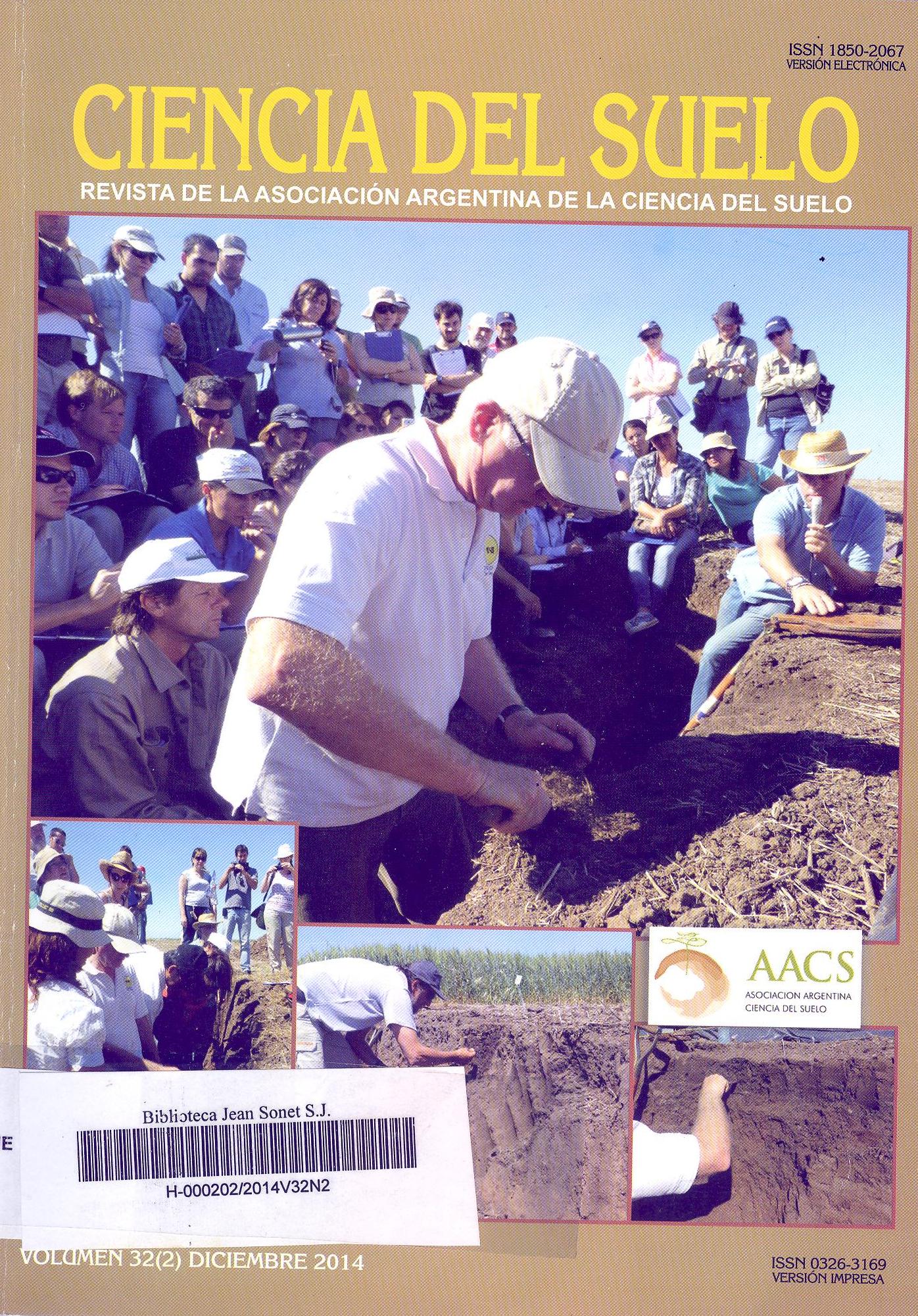Ver ítem
- xmlui.general.dspace_homeCentros Regionales y EEAsCentro Regional CórdobaEEA ManfrediArtículos científicosxmlui.ArtifactBrowser.ItemViewer.trail
- Inicio
- Centros Regionales y EEAs
- Centro Regional Córdoba
- EEA Manfredi
- Artículos científicos
- Ver ítem
Retencion y degradación de glifosato en mezclas de rastrojo de maíz y soja con suelo
Resumen
Se estudió el comportamiento de 14C-glifosato en la zona de transición rastrojo-suelo, en cuatro sitios y dos secuencias
de cultivo: monocultivo de soja (Glycine max (L) Merr), y rotación soja-maíz (Zea mays L). La adsorción-desorción se estudió
mediante isotermas y se prepararon las mezclas suelo+rastrojo con 1,5% (p/p) de rastrojo (mezclasoja, mezclamaíz). La distribución
entre las formas mineralizada (Min), extractable en agua (RE1) en hidróxido de
[ver mas...]
Se estudió el comportamiento de 14C-glifosato en la zona de transición rastrojo-suelo, en cuatro sitios y dos secuencias
de cultivo: monocultivo de soja (Glycine max (L) Merr), y rotación soja-maíz (Zea mays L). La adsorción-desorción se estudió
mediante isotermas y se prepararon las mezclas suelo+rastrojo con 1,5% (p/p) de rastrojo (mezclasoja, mezclamaíz). La distribución
entre las formas mineralizada (Min), extractable en agua (RE1) en hidróxido de amonio (RE2) y no extractable (RNE), se estudió
mediante incubaciones en mezclasoja que equivalió a 4,8 t ha-1 y 8,8 t ha-1 para mezclamaíz. Los índices Kfads, Kd
, y Kco promedio
de mezclamaíz (39,1 L kg-1; 39,9 L kg-1; 1822 L kg-1, respectivamente) superaron a los obtenidos en mezclasoja (35,1 L kg-1; 34,3
L kg-1; 1630 L kg-1). El Kco correlacionó significativamente con el C orgánico de las fracciones granulométricas del suelo, Cf
<50μm (0,74, p<0,001), C orgánico de la fracción 2000-200 μm (-0,66, p<0,001) y 200-50μm (-0,59, p<0,001). La histéresis
se incrementó con la adsorción. El porcentaje de 14C-CO2
liberado varió entre 59% a 76% del 14C inicial aplicado, en promedio
69% (mezclasoja) y 68% (mezclamaíz). Se detectó variabilidad entre mezclas del mismo rastrojo, en las mezclasoja (CV=10%) y
en las mezclamaíz (CV=6%). Los RE1 representaron el 1,5% (mezclasoja) y 1,1% (mezclamaíz), mientras que en mezclasoja el CV=65%
y en mezclamaíz el CV= 34%. Los valores promedio y CV de los RE2 fueron respectivamente 22% y 31% (mezclasoja) y 24%
y 21% (mezclamaíz). Los RNE representaron una pequeña fracción del total de la radioactividad, en promedio el 4,7% para
ambas mezclas, con un CVsoja = 14% y CVmaíz = 17%. Nuestros resultados indican que la zona de transición rastrojo+suelo
es una pequeña fracción, pero muy importante en el comportamiento de glifosato, y no debieran hacerse generalizaciones
en base al tipo de rastrojo.
[Cerrar]
Glyphosate [(N-phosphonomethyl) glycine] behavior was examined in straw-soil mix. Four sites and two crop sequences were selected, continuous soybean (Glycine max (L) Merr) and soybean-maize (Zea mays L) rotation. Glyphosate sorption was characterized by isotherms on straw+soil mix with 1.5% (w/w) of straw. Distribution of 14C-glyphosate radioactivity among mineralized fraction, two extractable fractions (in water: ER1 and NH4
OH: ER2), and
[ver mas...]
Glyphosate [(N-phosphonomethyl) glycine] behavior was examined in straw-soil mix. Four sites and two crop sequences were selected, continuous soybean (Glycine max (L) Merr) and soybean-maize (Zea mays L) rotation. Glyphosate sorption was characterized by isotherms on straw+soil mix with 1.5% (w/w) of straw. Distribution of 14C-glyphosate radioactivity among mineralized fraction, two extractable fractions (in water: ER1 and NH4
OH: ER2), and non-extractable fractions (NER)
were assessed under laboratory conditions such that mixsoybean was equivalent to 4.8 t ha-1 and 8.8 t ha-1 for mixmaize. Adsorption indexes Kfads, Kd , y Kco, were 39.1 L kg-1; 39.9 L kg-1; 1822 L kg-1, respectively for mixmaize and were higher than those obtained in mixsoybean (35.1 L kg-1; 34.3 L kg-1; 1630 L kg-1). Kco significantly correlated (p<0.001) with organic C by soil size particle, being for C fraction <50μm (0.74), C fraction 2000-200 μm (-0.66) and C fraction 200-50μm (-0.59). Hysteresis increased with increase of adsorption. Cumulative 14C-CO2 percentage evolved ranged between 59% and 76%. In average was 69%
(mixsoybean) and 68% (mixmaize). High variability between mixes with the same straw type was detected. Variation coeficient (VC) was 10% for mixsoybean and 6% for mixmaize. The RE1 accounted 1.5% (mixsoybean) and 1.1% (mixmaize), while the VC was 65% for mixsoybean and 34% for mixmaize. Average values of RE2 and the corresponding VC were respectively, 22% and 31%
(mixsoybean), 24% and 21% (mixmaize). NER represented a small fraction of the total radioactivity. In average 4.7% for both mixes, and again the high VC for the same straw type was detected:14% in mixsoybean and 17% in mixmaize Our results indicated that the ‘‘mulch’’ is a small fraction but very important on glyphosate behavior, and it should not make generalizations based on the type of straw.
[Cerrar]

Autor
Rampoldi, Edgar Ariel;
Hang, Susana Beatriz;
Barriuso, Enrique;
Fuente
Ciencia del suelo 32 (2), 271-282. (dic. 2014)
Fecha
2014-12
ISSN
1850-2067
Documentos Relacionados
Formato
pdf
Tipo de documento
artículo
Proyectos
(ver más)
INTA/PNNAT/1128043/AR./Los agroquímicos como fuente de contaminación difusa en agroecosistemas.
Palabras Claves
Derechos de acceso
Abierto
 Excepto donde se diga explicitamente, este item se publica bajo la siguiente descripción: Creative Commons Attribution-NonCommercial-ShareAlike 2.5 Unported (CC BY-NC-SA 2.5)
Excepto donde se diga explicitamente, este item se publica bajo la siguiente descripción: Creative Commons Attribution-NonCommercial-ShareAlike 2.5 Unported (CC BY-NC-SA 2.5)


